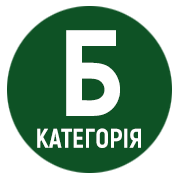THE FUNCTIONING OF THE ORIGINAL IMAGE IN THE PROCESS OF THE CREATIVE THINKING ACTIVITY OF HIGH SCHOOL STUDENTS IN COMPLICATED CONDITIONS
DOI:
https://doi.org/10.32782/psy-2024-3-13Keywords:
construction, information, task, creative thinking, strategy, imageAbstract
The basic components of divergent thinking are analyzed. The concepts of creative thinking and divergent thinking are developed. The functioning of associativity in the process of creative thinking is analyzed. The relationship between creativity and intelligence in the structure of a creative personality is substantiated. The idea of overgeneralized thinking on the scale of creativity, developed by H. Eysenck, is considered, as well as the prospects for the development of the psychology of creative thinking in the coordinate system of Campbell's theory. An analysis of the KARUS system, developed by V.O. Moliako. The expediency and reliability of its implementation as a tool for the implementation and interpretation of a person's creative thinking activity is proved. Creative thinking is considered as solving creative problems. The obtained results of the analysis of experimental data based on the results of the study of the functioning of subjective landmarks in the process of creative thinking of high school students are substantiated. Manifestations of strategies of analogizing, combining, and reconstructing during construction of the researched constructions were analyzed. The formation of landmark images in the process of creative thinking activity is related to the study of structural and functional characteristics of existing information structures. And therefore, constructive elements can turn out to be analogs-references: a) practically without being affected by transformative transformations; b) a subjective reference point is formed at the appropriate stage of constructive transformations, implementation of construction strategies, as a result of which new prognostic and necessary information is found for solving the actual problem, distant analogues, antipodes and their combinations are constructed and used for this purpose, which forms the basis of functioning landmark images in the process of creative thinking activity of an individual.
References
Функціонування творчого мислення в інформаційно-віртуальному просторі суб’єкта : монографія / В.О. Моляко, Ю.А. Гулько, Н.А. Ваганова та ін. ; за ред. В.О. Моляко. Київ, 2021. 165 с.
Campbell D. T. Blind variation and selective retention in creative thought as in other knowledge processes. Psychological Review. 1960. № 67. P. 380–400.
Dorfman L. A metaindividual model of creativity. New directions in aesthetics, creativity, and the arts / Eds. P. Locher, C. Martindale, L. Dorfman. New York: Baywood Publishing Co, 2005. P. 105–122.
Eysenck H.G. Genius: The natural history of creftivity. Cambridge : Cambridge University Press, 1995.
Furnham A., Crump Y., Batey M., Camorro-Premuzis T. Personality and ability predictors of the “Consequences” Test of divergent thinking in a large non-student sample. Personality and Individual Differences. 2009. № 46. P. 536–540.
Martindale C. The clockwork muse: The predictability of artistic styles. New York : Basic Books, 1990.
Martindale C. Creativity, attention, and cognitive disinhibition. La psicologia delle arti oggi / Ed. R. Tomassoni. Milano : Angeli, 2002. P. 89–99.
Martindale C. Creativity, primordial cognition, and personality. Personality and Individual Differences. 2007. № 43. P. 1777–1785.
Mednick S.A. The associative basis of the creative process. Psychological Review. 1962. № 69. P. 220–232.
Rothenberg A. Janusian process. Encyclopedia of creativity / Eds. M.A. Runko, S.R. Pritzker. San Diego : Academic Press. 1999. № 2. P. 103–108.
Silvia P.J., Winterstein B.P., Willse J.T. et al. Assessing creativity with divergent thinking tasks: Exploring the reliability and validity of new subjective scoring methods. Psychology of Aesthetics, Creativity, and the Arts. 2008. № 2 (2). P. 68–85.
Simonton D.K. Creativity and discovery as blind variation: Campbell’s (1960) BVSR model after the halfcentury mark. Review of General Psychology. 2011. № 15 (2). P. 158–174.
Staw B.M. An evolutionary approach to creativity and innovation. Innovation and creativity at work: Psychological and organizational strategies / Eds. M.A. West, G.L. Farr. New York : Wiley, 1990. P. 287–308.
Wilson R.C., Guilford J.P., Christensen P.R., Lewis D.J. A factor-analytic study of creative-thinking abilities. Psychometrika. 1954. № 19. P. 297–311.






